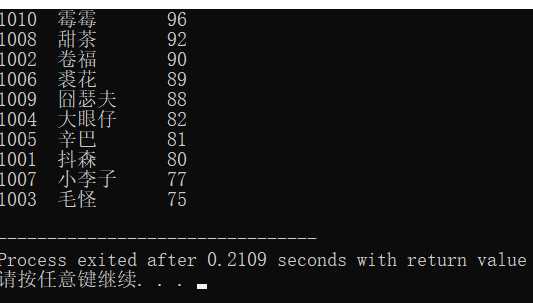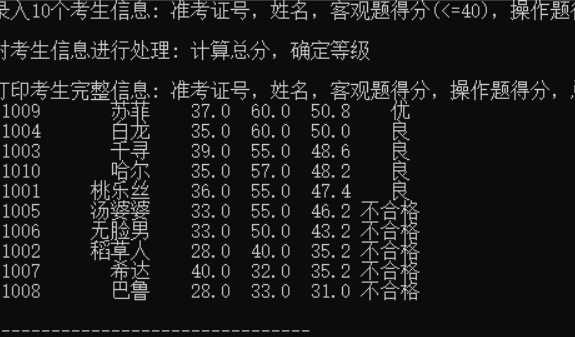#include <stdio.h>
#include <stdlib.h>
int main()
{
FILE *fin, *fout;
int ch;
fin = fopen("file1.txt", "r");
if (fin == NULL)
{
printf("fail to open file1.txt\n");
exit(0);
}
fout = fopen("file2.txt", "w");
if (fout == NULL)
{
printf("fail to open or create file2.txt\n");
exit(0);
}
while( !feof(fin) )
{
ch = fgetc(fin);
if(ch >= ‘a‘ && ch <= ‘z‘)
ch -= 32;
fputc(ch, fout);
}
fclose(fin);
fclose(fout);
return 0;
}

// 从文本数据文件file1.dat中读入数据,按成绩从高到低排序,将排序结果输出到屏幕上,同时以文本方式存入文件file3.dat中。
#include <stdio.h>
#include <stdlib.h>
#define N 10
// 定义一个结构体类型STU
typedef struct student {
int num;
char name[20];
int score;
}STU;
void sort(STU *pst, int n); // 函数声明
int main() {
FILE *fin, *fout;
STU st[N];
int i;
// 以只读文本方式打开文件file1.dat
fin = fopen("file1.dat", "r");
if( !fin ) { // 如果打开失败,则输出错误提示信息,然后退出程序
printf("fail to open file1.dat\n");
exit(0);
}
// 从fin指向的数据文件file1.dat中读取数据到结构体数组st
for(i=0; i<N; i++)
fscanf(fin, "%d %s %d", &st[i].num, st[i].name, &st[i].score);
fclose(fin); // 关闭fin指向的文件file1.dat
// 调用函数sort()对数组st中数据,按分数又高到低排序
sort(st, N);
// 以写方式打开/创建文本文件file3.dat
fout = fopen("file3.dat", "w");
if( !fout ) { // 如果打开失败,则输出错误提示信息,然后退出程序
printf("fail to open file1.dat\n");
exit(0);
}
// 将排序后的数组st中数据输出到屏幕,同时,也写入文件file3.dat
for(i=0; i<N; i++) {
printf("%-6d%-10s%3d\n", st[i].num, st[i].name, st[i].score);
fprintf(fout, "%-6d%-10s%3d\n", st[i].num, st[i].name, st[i].score);
}
fclose(fout); // 关闭fout指向的文件file3.dat
return 0;
}
// 函数功能描述:对pst指向的n个STU结构体数据进行排序,按成绩数据项由高到底排序
// 排序算法:冒泡法
void sort(STU *pst, int n) {
STU *pi, *pj, t;
for(pi = pst; pi < pst+n-1; pi++)
for(pj = pi+1; pj < pst+n; pj++)
if(pi->score < pj->score) {
t = *pi;
*pi = *pj;
*pj = t;
}
}

#include <stdio.h>#include <string.h>#include <stdlib.h>const int N = 10;// 定义结构体类型struct student,并定义其别名为STUtypedef struct student { long int id; char name[20]; float objective; /*客观题得分*/ float subjective; /*操作题得分*/ float sum; char level[10]; }STU;// 函数声明void input(STU s[], int n);void output(STU s[], int n);void process(STU s[], int n);int main() { STU stu[N]; printf("录入%d个考生信息: 准考证号,姓名,客观题得分(<=40),操作题得分(<=60)\n", N); input(stu, N); printf("\n对考生信息进行处理: 计算总分,确定等级\n"); process(stu, N); printf("\n打印考生完整信息: 准考证号,姓名,客观题得分,操作题得分,总分,等级\n"); output(stu, N); return 0;}// 从文本文件examinee.txt读入考生信息:准考证号,姓名,客观题得分,操作题得分void input(STU s[], int n) { // 补足代码 FILE *fin; int i; // 以只读文本方式打开文件examinee.txt fin = fopen("examinee.txt", "r"); if( !fin ) { // 如果打开失败,则输出错误提示信息,然后退出程序 printf("fail to open file\n"); exit(0);} for(i=0; i<n; i++) { if(fscanf(fin, "%ld %s %f %f", &s[i].id, s[i].name, &s[i].objective,&s[i].subjective)==0); // 从fin指定的文件中格式化读取一个学生信息 printf("读取错误!"); } fclose(fin);}// 输出考生完整信息: 准考证号,姓名,客观题得分,操作题得分,总分,等级// 不仅输出到屏幕上,还写到文本文件result.txt中void output(STU s[], int n) { int i; FILE *fout; // 以只读文本方式打开文件result.txt fout=fopen("result.txt","w"); printf("准考证号 姓名 客观题得分 操作题得分 总分 等级\n"); fprintf(fout,"准考证号 姓名 客观题得分 操作题得分 总分 等级\n"); for(i=0; i<n; i++) { printf(" %-9ld%-10s%-13.2f%-10.2f%-7.2f%-8s\n",s[i].id,s[i].name,s[i].objective,s[i].subjective,s[i].sum,s[i].level); fprintf(fout," %-9ld%-10s%-13.2f%-10.2f%-7.2f%-8s\n",s[i].id,s[i].name,s[i].objective,s[i].subjective,s[i].sum,s[i].level);}fclose(fout);}// 对考生信息进行处理:计算总分,排序,确定等级void process(STU s[], int n) { // 补足代码int i,j,k;int a1,a2;a1=(int)(N*0.1),a2=(int)(N*0.5);STU temp;for(i=0;i<n;i++)s[i].sum=s[i].objective+s[i].subjective;for(j=0;j<n-1;j++)for(k=0;k<n-j-1;k++)if(s[k].sum<s[k+1].sum){temp = s[k];s[k] = s[k+1];s[k+1] = temp;}for(i=0;i<a1;i++)strcpy(s[i].level,"优秀");for(i=a1;i<a2;i++)strcpy(s[i].level,"合格"); for(i=a2;i<n;i++) strcpy(s[i].level,"不合格");} 
原文:https://www.cnblogs.com/ssyxs/p/11080073.html